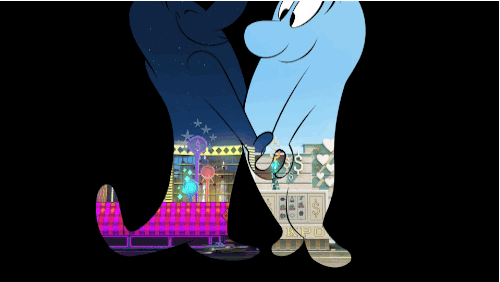Here is a research blog about the 12 Principles of Animation.
1. Squash and Stretch – The very first principle of animation is the squash and stretch principle. What this does is that it gives the illusion of weight volume and mass to a character as when they. move. This is done by expanding and shrinking the character’s body. For example, the gif below is a quick scene from the Pixar short Day and Night. As you can see, as the two characters dance around, their body shapes are compress very slightly and then stretch back into shape. This gives the illusion that they are actually dancing because we see the impact that gravity has on their bodies.

2. Anticipation – Anticipation is used to let the people watching know that a major action is about to happen. To do this, animators will often work in a smaller action or two, right before the major action to signal that something is coming. As you can see in the gif, Thumper lifts up his leg before running into action.

3. Staging – This principle is all about giving characters a pose or an action that clearly lets the audience know their intentions or emotions that they are feeling. For example, in the image below, For part A, if you make a silhouette of Jiminy Cricket, eating ice cream, you can clearly see what hes doing and that he’s enjoying it, this is good staging as you’re letting the people know what is happening. But however, for part B you cannot see what is happening as the ice cream is positioned infront of him, so you can’t see as clearly what emotions and feeling Jiminy is feeling. Sure, he’s smiling, but it doesn’t really emphasis what is actually going on.

4. Straight Ahead and Pose to Pose – Straight ahead and pose to pose refers to the techniques by which the animation is crafted. This technique involves drawing the key poses that you’d like the character to take first and then filling in the poses in between afterwards. The straight ahead technique is more nuanced and involves an animator literally crafting one frame after another, which takes a very long time. The other technique, Straight ahead, is a lot better for creating fluid, realistic actions while pose to pose is better for dramatic or emotional scenes where it’s more about conveying an idea than a sense of realness.
5. Follow Through and Overlapping Action – The follow principle is when a character is in action and stops, nothing stops all at once. So when a character is running and stops, their main body will stop, but the other parts of their body will keep moving for a bit after. For instance, in this scene, Mulan’s head stops first and then her hair does.

6. Slow-In and Slow-Out – Slow-in and slow-out is another principle designed to make characters look more realistic. When characters are performing actions, animators will draw more frames at the start of the action, less frames in the middle, and more frames again at the end of the action to create this slow-in/slow-out effect. As seen in the GIF below.

7. Arc – The arc principle is that almost all actions in life have a slightly circular motion. When a head turns or an arm moves, rarely will it thrust straight in and straight out. Often it will have a little curve to it.
8. Secondary Action – A secondary action is an additional action that reinforces and adds more dimension to the main action.
9. Timing – Timing helps create the illusion that an action is abiding by the laws of physics. By adjusting the timing of a scene, animators can make that scene look either slower and smoother (with more frames) or faster and crisper (with less frames). As seen in this scene from the Incredibles.

10. Exaggeration – Exaggeration is all about overstating certain movements in a way that helps evoke a point, yet doesn’t ruin the believability of the scene. Its prime example is in the classic Tom And Jerry Cartoons whenever a character gets hurts, or is conveying an emotion.

11. Solid Drawings – This principle encourages animators to be mindful of the fact that while forms may be presented in 2D, they should strive to look 3D.
12. Appeal – Obviously, not every character should be appealing. But this principle posits that animators should strive to create images that will be interesting and compelling to audiences.
And there it is. The 12 principles of animation.


Leave a comment